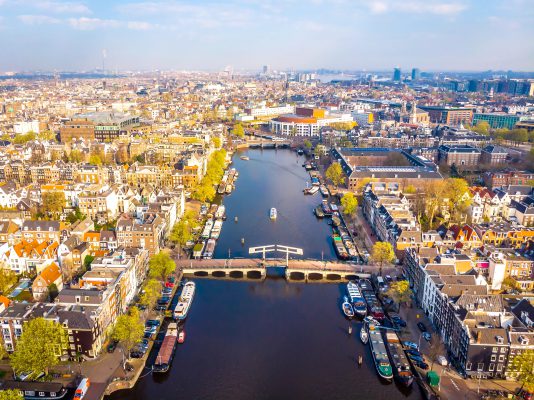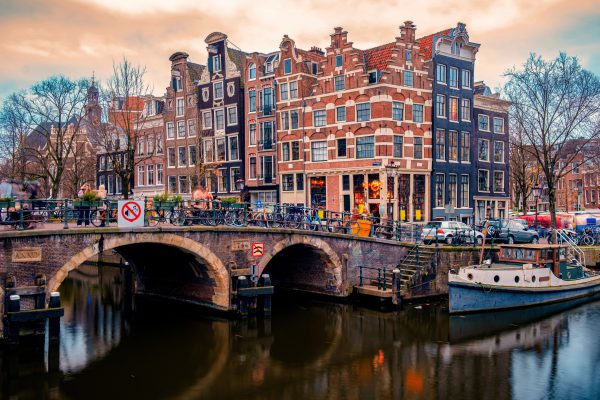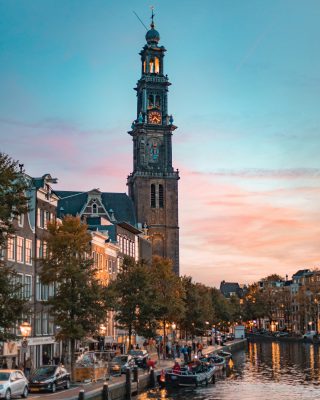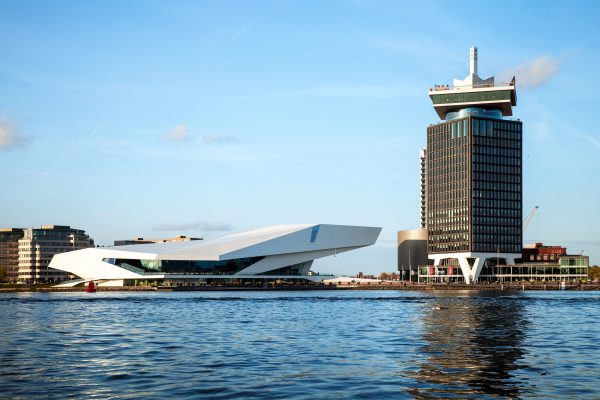For any expat arriving in the Netherlands, Amsterdam is often the first city to explore, and for good reason. Compact, walkable and pulsing with life, it is a city that combines a rich history with modern innovation, and charming traditions with a cosmopolitan outlook. While tourists may be drawn to the clichés of tulips and bikes, expats will discover a layered and dynamic city that rewards those who dig a little deeper.
Let’s take a journey through the origins of Amsterdam and then explore the neighbourhoods that give the city its unique flavour.
From riverbanks to a global trading power: A short history of Amsterdam
Amsterdam’s story begins around the year 1000, when farmers and fishermen settled along the river Amstel, which emptied into the IJ. Life was modest and marshy, but the location strategic. Around 1250-1275, the construction of a dam in the Amstel led to the name Amstelerdam, which evolved into Amsterdam. The dam helped create a new harbour and marketplace, giving rise to Damrak and the modern-day Dam Square – still the beating heart of the city.
By the early 1300s, Amsterdam received city rights from the Bishop of Utrecht, officially marking its status as a Dutch city. Trade connections, especially with Scandinavian countries, accelerated Amsterdam’s growth in the 14th century. The city expanded its canal network and became a hub for storing and distributing goods like grain, beer, and timber. By 1400, the population had reached about 3,000.
But it was the Golden Age (1580–1700) that truly transformed Amsterdam. The Spanish occupation of Antwerp redirected trade routes to the north, making Amsterdam the dominant commercial hub. In 1595, Cornelis de Houtman led the first Dutch voyage to the East Indies, opening a floodgate of international trade. To streamline competition, the Dutch government formed the Dutch East India Company (VOC), the world’s first multinational corporation, headquartered in Amsterdam. The city also established the first stock exchange and the Amsterdam Wisselbank, solidifying its position as the financial capital of Europe.
The wealth from trade led to the flourishing of art and intellect. Painters like Rembrandt and poets Joost van den Vondel and P.C. Hooft became household names. In 1632, the Athenaeum Illustre, a precursor to the University of Amsterdam, was established.
However, the 19th century brought challenges. The Napoleonic Wars and loss of colonies led to economic stagnation. But from 1860 onwards, the Industrial Revolution reshaped the city. New railways, steamships and industrial zones attracted thousands of rural labourers. By 1900, the population had ballooned to over 500,000. Poor living conditions led to the rise of housing cooperatives, resulting in the development of new neighbourhoods like De Pijp, Dapperbuurt and Kinkerbuurt.
The early 20th century saw further expansion, with Amsterdam annexing nearby towns and developing new residential areas. The housing act of 1901 improved worker housing, particularly in Amsterdam-Noord and Watergraafsmeer. By 1930, Amsterdam had 750,000 inhabitants.
In more recent decades, especially since the 1980s, Amsterdam has reinvented itself once again. Former working-class districts like the Jordaan and De Pijp became highly desirable. The city modernized its financial and business infrastructure, with international companies moving into the Zuidas area. In 2010, the canal ring was designated a UNESCO World Heritage site, cementing its reputation as one of the most beautiful cities in the world.
Exploring the Neighbourhoods of Amsterdam
Amsterdam is often described as a village in the body of a city. Its neighbourhoods are highly distinct, each with its own personality, pace, and perks. Here’s a tour of some key districts to help expats orient themselves.
Centrum (city centre)
The city’s historical core. Touristy? Absolutely. But also rich in hidden gems. The canal belt, or Grachtengordel, is filled with 17th-century townhouses, iconic museums like the Hermitage, and tranquil spots like the Begijnhof. Shopping ranges from the high-street Kalverstraat to quirky boutiques in the Nine Streets. The red-light district and Chinatown around Nieuwmarkt reflect the city’s layered, liberal history.
De Jordaan
Originally a working-class neighbourhood, the Jordaan is now one of the most desirable areas to live. Its narrow streets, art galleries and traditional cafes maintain an authentic charm. The Negen Straatjes (Nine Streets) are a paradise for boutique lovers. Live music, flower markets and hidden courtyards give this district an irresistibly romantic vibe.
De Pijp
This former working-class neighbourhood has evolved into a vibrant, multicultural melting pot. Centred around the Albert Cuyp Market, De Pijp is a haven for foodies. From Surinamese and Nepalese to Indonesian and Middle Eastern eateries, this area offers a taste of the world. The Sarphatipark provides a green escape amidst the urban buzz.
Oud-West
Trendy and laid-back, Oud-West is popular among young professionals. The centrepiece is De Hallen, a converted tram depot that houses a food hall, cinema and design shops. It’s an ideal mix of quiet residential streets and buzzing local businesses.
Oud-Zuid
Chic and elegant Oud-Zuid is where you’ll find the famous Museumplein, home to the Rijksmuseum, Van Gogh Museum and Stedelijk Museum. The area is also known for upscale shopping on the P.C. Hooftstraat and the sprawling Vondelpark. Expect stately villas and top-tier international schools.
Amsterdam-Noord
Accessible by a short (and free) ferry ride, Noord is Amsterdam’s edgy, up-and-coming area. Industrial warehouses now house creative startups, breweries and Europe’s largest flea market. Visit the EYE Film Museum or grab a drink at a bar overlooking the IJ. Many expats compare it to Brooklyn – but with more bikes.
Bos & Lommer/De Baarsjes
Once overlooked, these neighbourhoods have undergone a renaissance thanks to local initiatives. You’ll find pop-up stores, boho boutiques and a strong community vibe. These districts strike a balance between affordability and creativity, making them popular with young families and artists.
Oost & Watergraafsmeer
Eastern Amsterdam offers an eclectic mix. The Indische Buurt is alive with multicultural flair, from Turkish grocers to hip cafes. The nearby Oosterpark is a favourite for locals to relax, exercise or attend small festivals. Watergraafsmeer, with its broad avenues and 1930s houses, appeals to those seeking a quieter, family-friendly vibe.
Oostelijk Havengebied (Eastern Docks)
Love architecture? Then head east. The former harbour has been transformed into a modern architectural showcase. Walk along the docks, explore unique bridges and houses, and enjoy scenic views of the IJ. Czaar Peterstraat is gaining fame as a hotspot for local design and artisan foods.
Living in Amsterdam as an expat
So what makes Amsterdam so liveable for internationals? For one, nearly everyone speaks English fluently. The city is compact and well-connected by bike, tram, bus and metro. Cultural life is vibrant, from open-air music festivals to intimate jazz bars, from global cuisine to centuries-old cafes.
Moreover, Amsterdam boasts a strong sense of community. Whether you’re a tech worker in Zuid, an artist in Noord or a family settling in Watergraafsmeer, there’s a neighbourhood that suits your style.
Housing can be a challenge due to high demand, but housing corporations and rental platforms are adapting to meet the needs of newcomers. Health care, education and public services are generally of high quality and accessible.
In many ways, Amsterdam is a city of contrast: old and new, intimate and international, relaxed and ambitious. But what ties it all together is its human scale and open-mindedness. It is a place where people from all walks of life live, work and cycle side by side.
Final thoughts
Amsterdam is more than a weekend destination. For expats, it offers a chance to be part of a rich history while contributing to its exciting future. Whether you’re admiring a Rembrandt, haggling over tulips at a market, or biking to your favourite café, you’re part of a city that has always embraced change.
So take your time. Wander its canals. Explore its neighbourhoods. Meet the locals. And, before long, you won’t just be living in Amsterdam – you’ll be part of it.



